Getting over the Corona jet lag: A roadmap for Travel industries in Digital World 2.0
 Chris Baldwin
Chris Baldwin
May 4, 2020
 Chris Baldwin
Chris Baldwin
May 4, 2020
 Chris Baldwin
Chris Baldwin
May 4, 2020
 Chris Baldwin
Chris Baldwin
May 4, 2020
As the cabin pressure rises for travel industry workers, social media is brimming with #TakeMeBack and #ThrowBack photos of yearnful customers. People want to know when they’ll be able to dash off on a plane next and discover new skies. For the tourism industry though, it is a struggle to even picture the uncertain future, bridled with many challenges.
The world is starting to slowly recover from the outbreak, and the old habits of traveling will surely come back, but we’re a long way from there. Imposed quarantines and travel bans have hit travel industries in a dire way. IATA estimates that nearly 25 million jobs in aviation and its related value-chains are at risk because of the current crises.
As with all crises, this one also shows the indispensable need to adapt fast in business. We witness the novel ways and rapid changes that each industry is trying to implement as they make attempts at recovery.
In this blog, we’ll walk you through the state of travel industries, the recent trends in each industry and delve into what you should do as a marketer working in these industries — right now and in the upcoming months — to brace the crisis and be ready for the new normal.
Leaving Middle Seats Empty
Hotel Rooms as a Break From WFH
Take These Actions as You Stay Put
Cross-Check and Get Ready to Take Off
Keep In Mind As You Leave
The hit taken by the airline industry, an estimated $171 billion dollar industry, affects the entire economy in major ways. This list published by Forbes shows the airline companies that have suspended flights, and paints the scope of the crises. Nearly 50 companies suspended all flights, and aviation giants like SAS, Lufthansa, and Air France have canceled 98% of their flights during this period.
Insider’s live dashboard, fed by our partner data and updated on a daily basis, also shows a consistent declining trend in the number of sessions, the conversion rate, and revenue of Airlines & Airports.
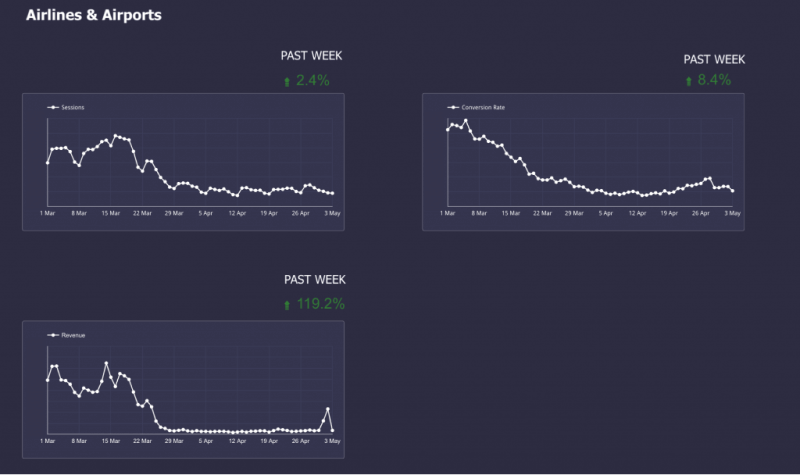
Meanwhile, airlines started debating whether to leave middle seats empty to ease the transition of worried customers once the sanctions are lifted. The budget airline Easy Jet has been leading the debate while exploring new ways to recover rapidly after the outbreak.
With barely anyone flying, OTAs have to also brace the tough patch. Many OTA brands reported a whopping fall in their revenues. Expedia mentioned that the crises could cost $30-40 million in the first quarter of the year.
Even though the hospitality sector tried to do their best with non-flying customers, hotels too have been going through hard times. According to VOX, hotel vacancy rates in the US fell by 25-50 percent as of mid-March, and the revenue per booked room fell by a third. Because of the incredibly low occupancy rates, keeping hotels open does not make sense financially.
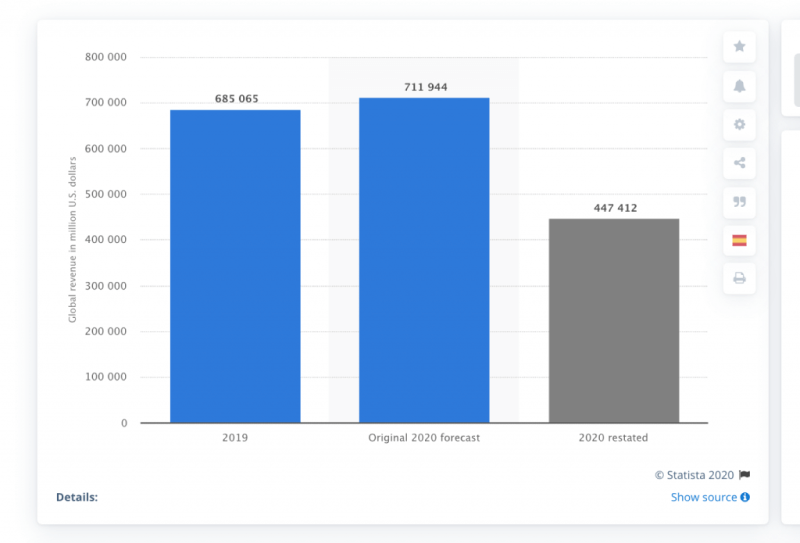
A recent study shows the forecasted change in worldwide revenue from the travel and tourism industry due to the outbreak, from 2019 to 2020. There is a 34.7% decrease compared to 2019. And the forecasted revenue for this year is 712 billion dollars less than the actual numbers of today.
Yet hotels are coming up with new ways to deal with the situation. Since people stopped traveling for leisure and business, hotels started repurposing their rooms as “offices with a view” offering customers safe zones with great hygiene, privacy, and the internet. And try to brand staying in a hotel as a break from Work From Home.

On the other hand, Hilton Hotels have started a new campaign in collaboration with American Express. They offer the chance to spend shopping points to use on hotel stays in the future. On their website banner, it is clear that they are sensitive to the current situation and are coming up with ways to stay in touch with their customers for the (hopefully) near future.
Airbnb, the lodging company that enabled on budget millennials to travel the world, is also facing the crisis in a rough way. The company created a $250 million fund to reimburse the hosts on the website who make a living by renting out their spaces. Some hosts started adding the line “thoroughly disinfected” to their listings to ensure bookers of the safety of their places.
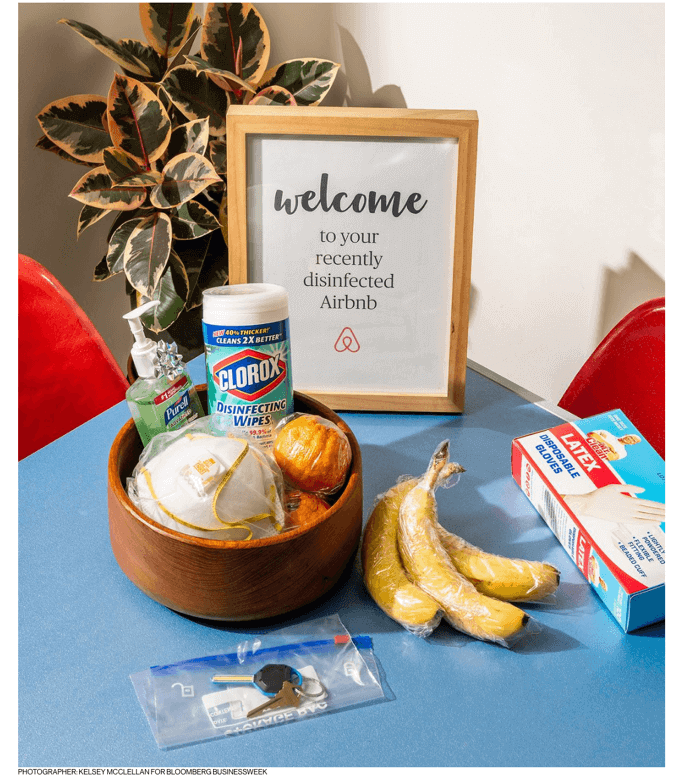
All these measures are ways of dealing with the crisis at hand in the best way possible. But there’s much more you can do to keep your brand relevant and engaged with customers. This slow period is your incubation time. It is now the time to invest in the future to be 100% ready to recover the lost revenue once things get back to normal.
While travel bans last, there are important things that marketers in the travel industries can do to establish valuable relationships with their customers.
1 – Keep Your Customers Updated and Informed
Customers who have done business with you in the past my need to alter their bookings. You may have potential customers who are window shopping for the next time they’ll be able to travel. They all need to know your cancellation and refund policies during the crisis.
Keep them informed and explain whether you are providing any flexibility for future booking. Focus on improving the customer experience while displaying this important information. KLM airlines have made all COVID-related updates central and super easy to find on their websites.
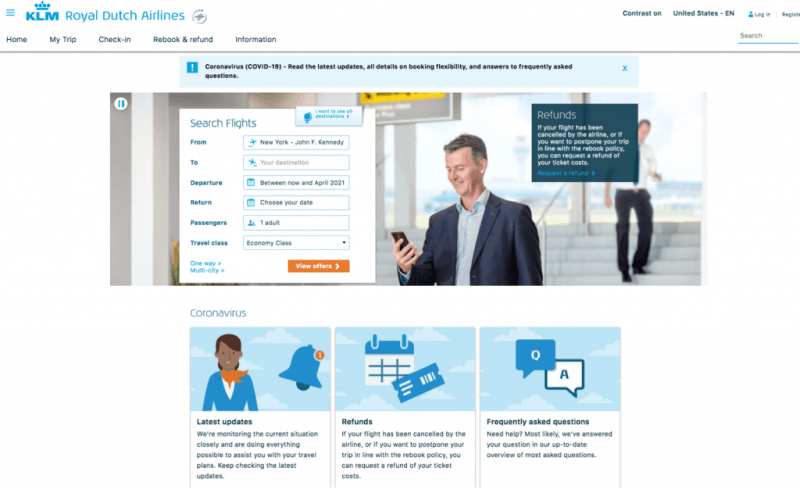
2 – Working on Brand Loyalty Is Always a Good Idea
Your customers have been focusing on essential items for a while now and planning a trip may not be anybody’s priority at the moment, but it won’t stay this way forever. Once the social distancing ends, your customers will be exploring every option to take a break and reward themselves. Optimize your campaigns for establishing brand loyalty, now.
Keep your customers engaged without a revenue goal in the picture for now. Stay in their minds, and show them your relevance. The following ads show how these brands are bracing the crisis by projecting confidence and patience to their customers.


Travel industry marketers need to invest their effort into creating aspirational content and imbue hope with a positive outlook.
3 – Optimize Email Captures to Contact Your Customers When the Time Comes
Capture emails and contact information from potential customers during this time in order to reach out to them with your best offers and tips when the time comes, because it will come.
Try to be as creative and contextual as possible with these capture prompts and entice your customers to stay in touch.

When the sanctions are lifted, and things will slowly go back to normal, the competition will be fierce and brands delivering the best customer experience and personalized offers will be in a better position. Make your plans and get ready for a massive influx of traffic as soon as travel bans lift and strategize to bounce back and recover lost revenue.
Here are top proven strategies to make your brand more engaging and your customer experiences more cohesive and delightful.
4 – Give Your Users a Reason to Spend Quality Time on Your Site
When your users will start to look for the best options to get away from all the solitary quarantine times, your brand should be ready to offer them the best content and offers. Engaging your users in an entertaining way as soon as they land on your site is not as hard as you may think. Grab their attention and give them a reason to spend their quality time on your website as they fuel their dreams and make plans. Use InStory to lure them into a gamified and visually engaging experience. Leverage visual stories and location detection to deliver AI-backed & personalized experiences. Engaging and converting your users take the swipe of a finger with InStory.
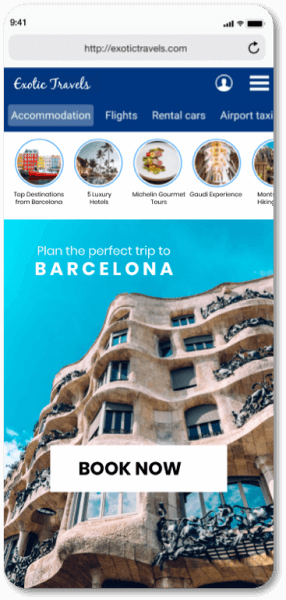
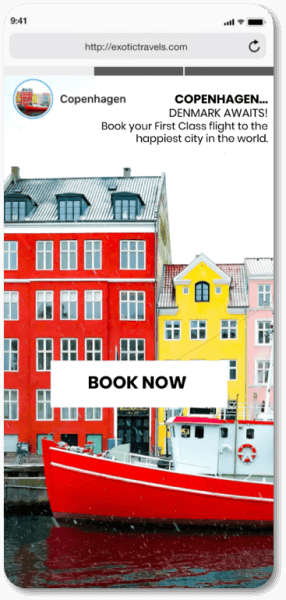
5 – Offer Personalized Delights to Boost Ancillary RevenueWho doesn’t like being pampered, remembered, and taken care of? Especially when you’re on your way to take a break. According to Google, 67% of travelers feel more loyal to companies that share information during their journeys that helps improve the vacation experience. Why not be one of those brands?
To offer the most satisfactory customer experiences, build hyper-personalized offers for your customers. Save them time by anticipating their needs and wishes. According to McKinsey & Company, purchase add-ons bring in up to $55 billion a year. You too can maximize ancillary revenue with personalized add-on recommendations. Use Insider’s auto-filled forms to minimize booking abandonment and offer the best deals to travelers. Deliver personalized travel add-ons & upgrades to boost engagement, conversions, and ancillary revenue.
If you have AI-powered data that tells you when your customers are traveling with an infant, then you can offer options like extra luggage or meals at special prices to convert them.
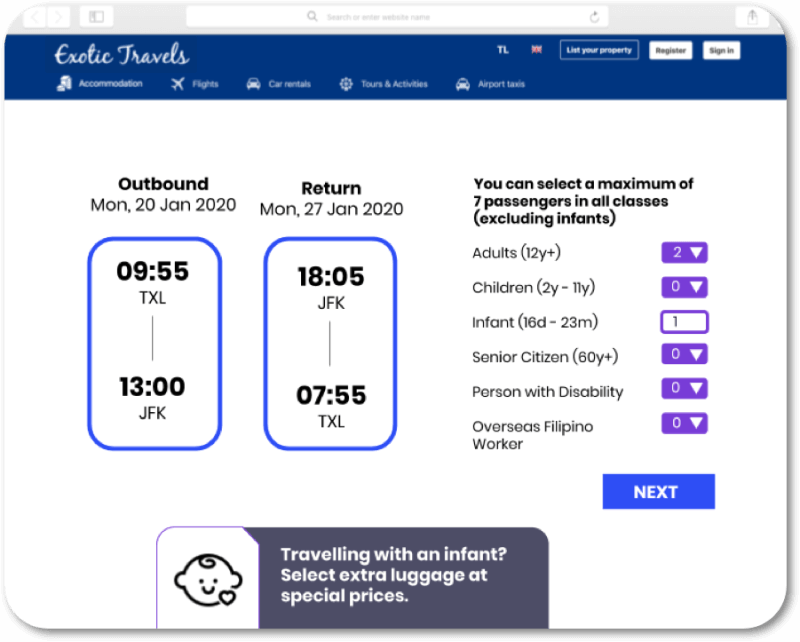
6 – Reach Your Customers From Every Channel
In an increasingly online-first world, 94% of bookers switch between devices before making a purchase. Conversion rates differ across devices. While many customers prefer doing their research on mobile devices, they tend to finish the purchase step through a desktop computer.
With Insider’s journey builder tool Architect, you can meet the travelers where they are and present offers when they are active. Even if a customer browsed on your website on her mobile device, you can still power conversations across channels to bring the visitor back into the funnel with personalized customer journeys. Follow up on your visitors and nudge them back during their journey to make a purchase. With Architect, you can connect with customers on all touchpoints like email, web and mobile push, and Facebook Messenger.
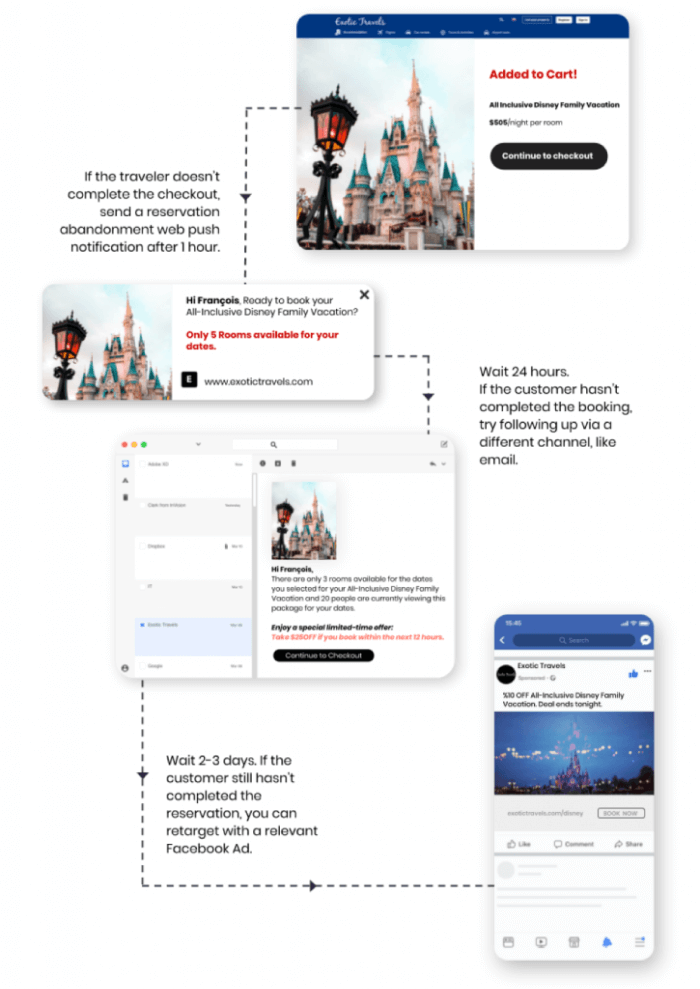
As the world sluggishly recovers from the outbreak, it is up to marketers to embrace the new normal and reimagine customer experiences in the Digital World 2.0. Even though it may look very far today, the day will come when your customers will be planning for their upcoming vacations. You need to be on your marks and be super-ready for that time to make up for the lost revenue during this quarter. Make sure to use our best practices and proven advice when planning your marketing campaigns. Airline marketers, don’t miss out on The Ultimate Digital Growth Guide for Airline Marketers for more great insight, and OTA marketers, you get your special guide too: access our The Ultimate Digital Growth Guide for OTA Marketers for best practices.
If you’d like to see how we help the world’s top travel and hospitality brands like Singapore Airlines, Thai Airways and Pegasus, book a personalized demo with one of our digital growth experts and discover how Insider can help your brand grow.

Written by
Chris Baldwin
Chris is an award-winning marketing leader with more than 12 years experience in the marketing and customer experience space. As VP of Marketing, Brand and Communications, Chris is responsible for Insider's brand strategy, and overseeing the global marketing team. Fun fact: Chris recently attended a clay-making workshop to make his own coffee cup…let's just say that he shouldn't give up the day job just yet.